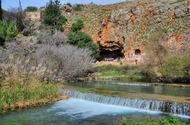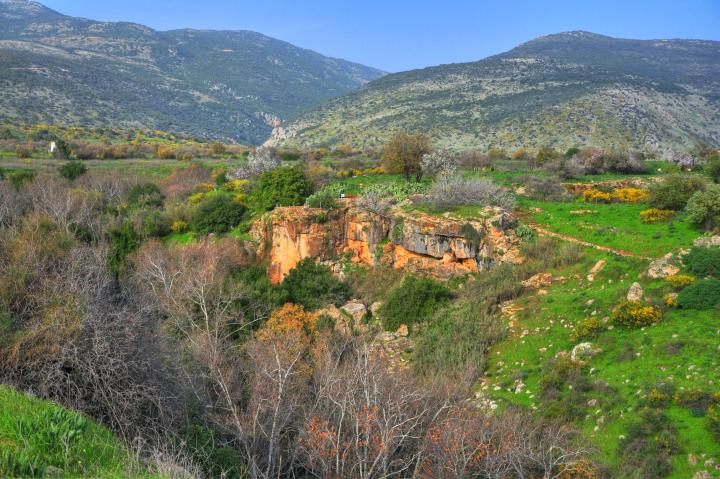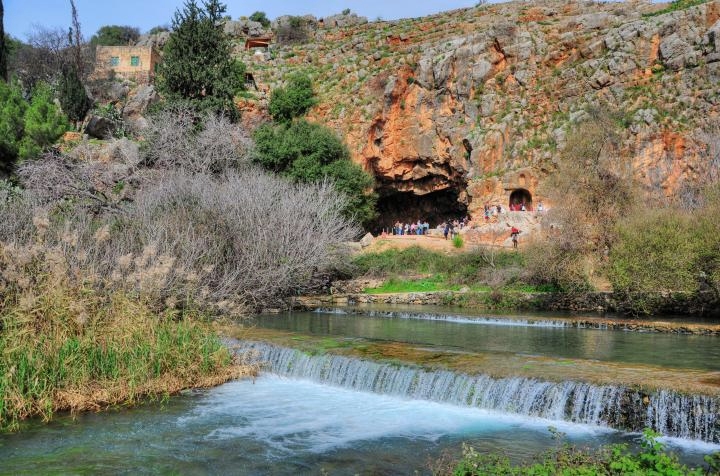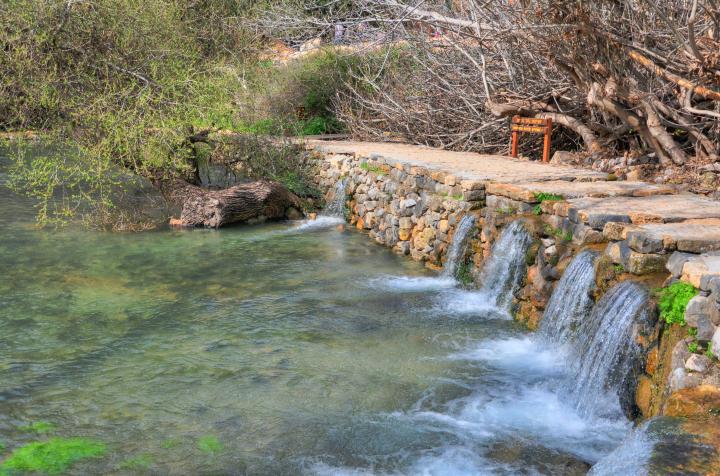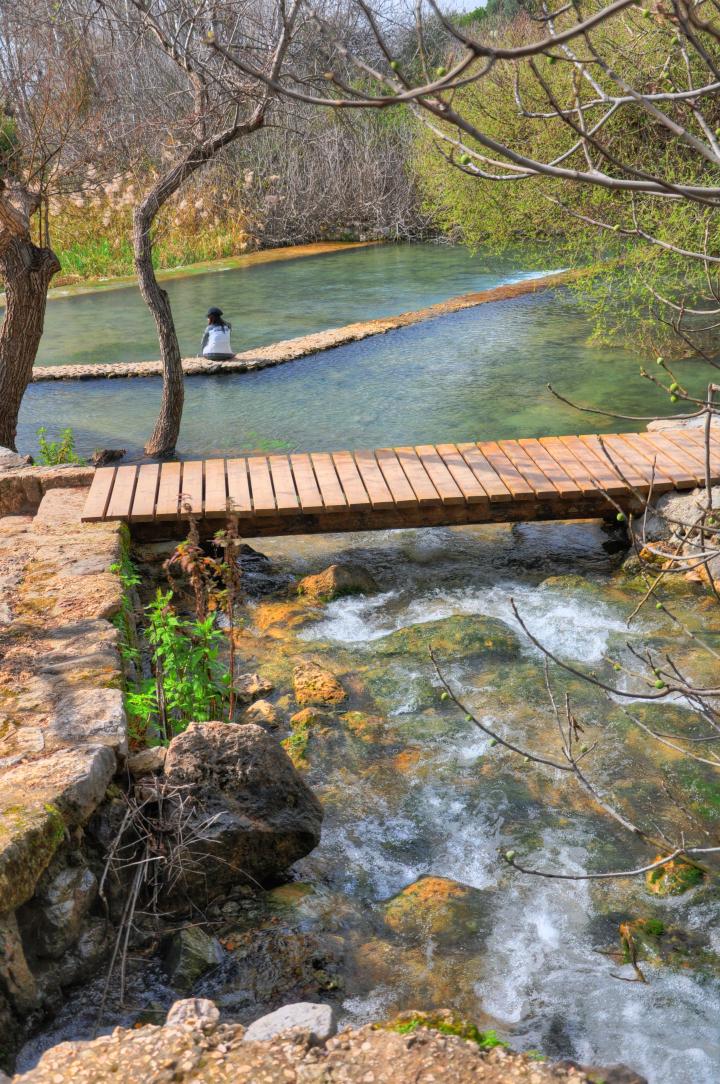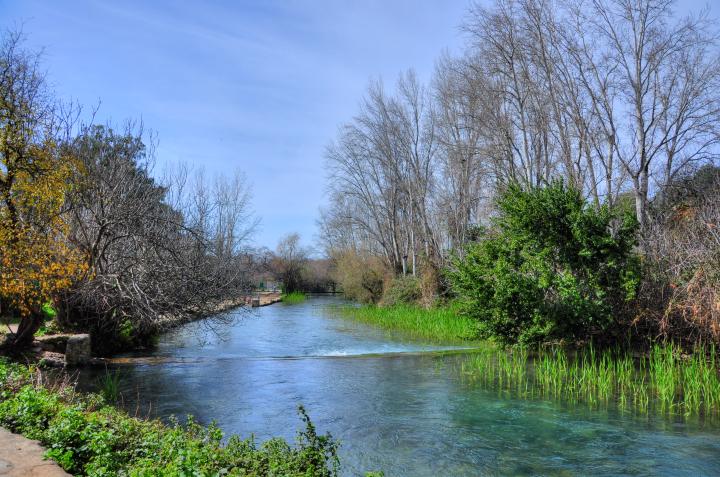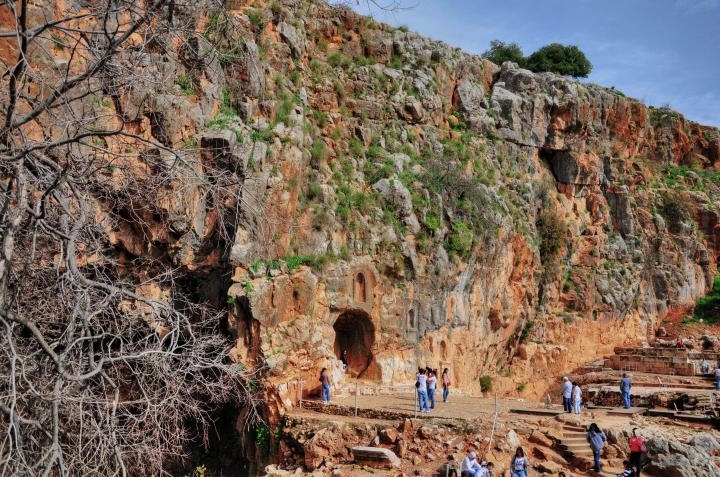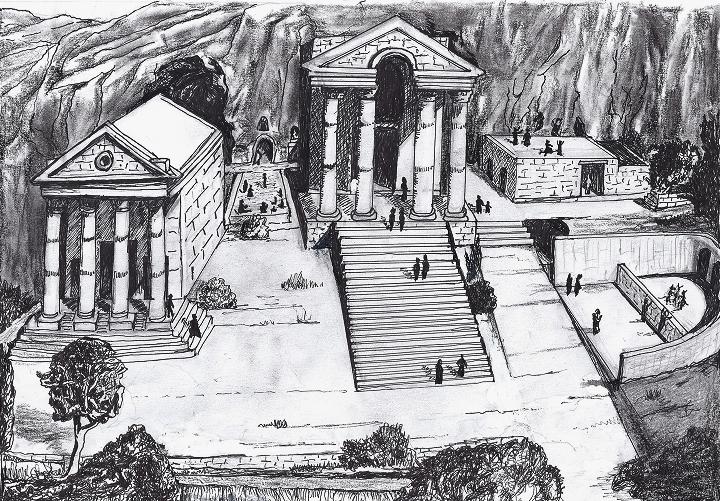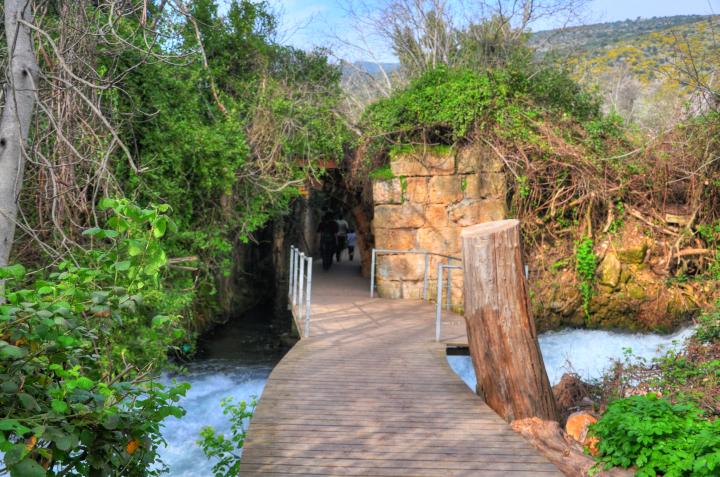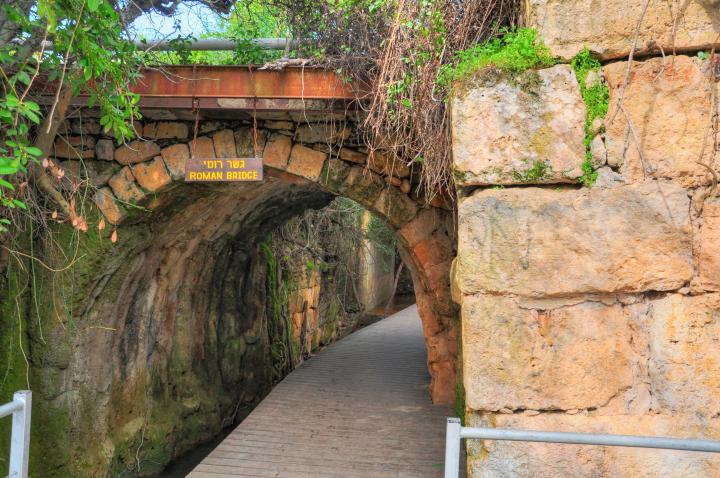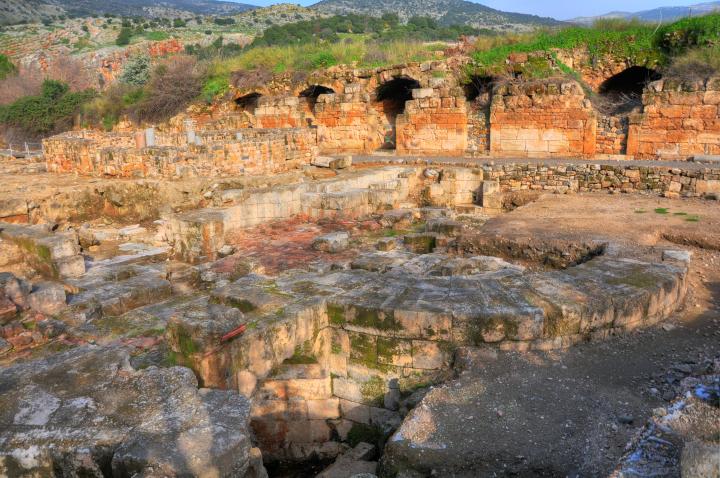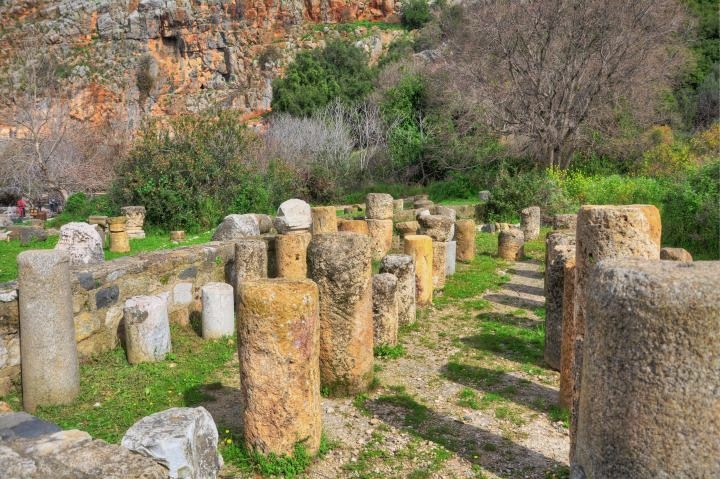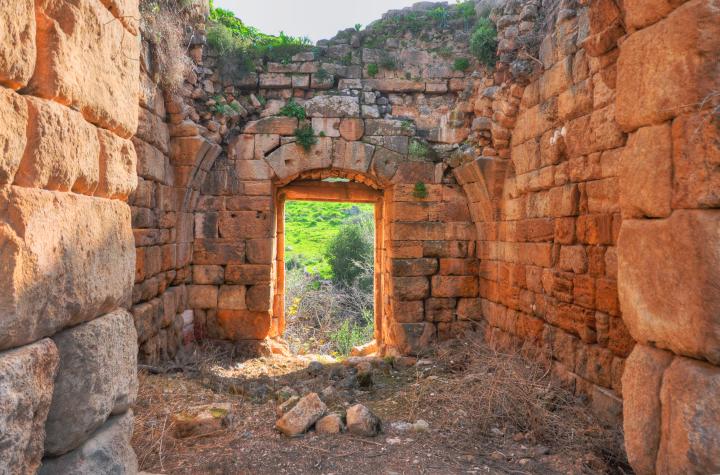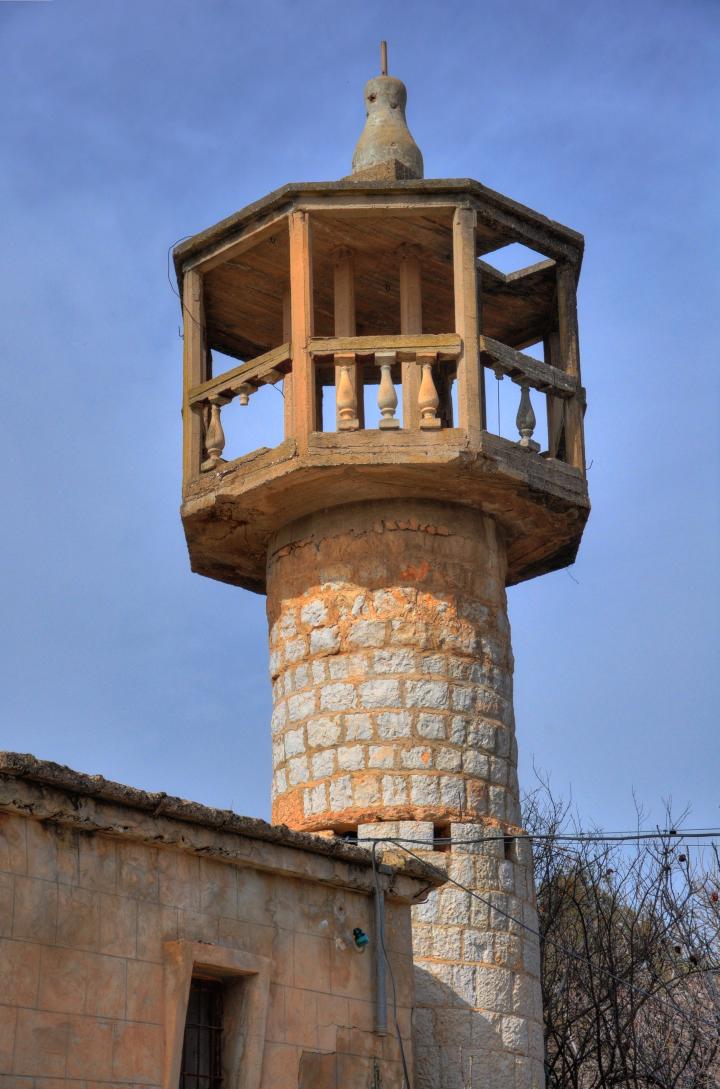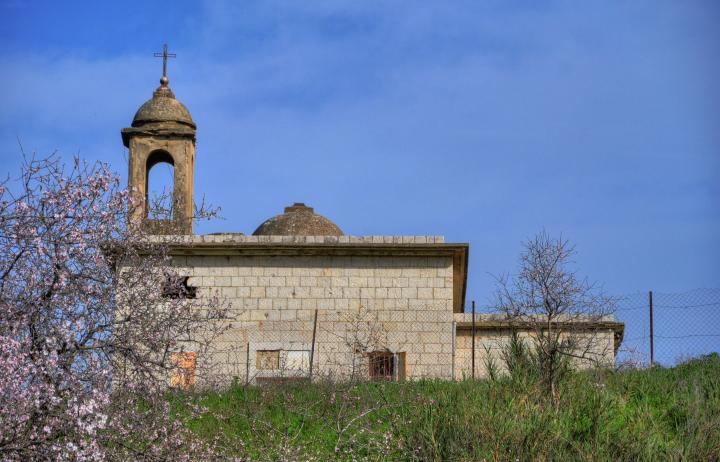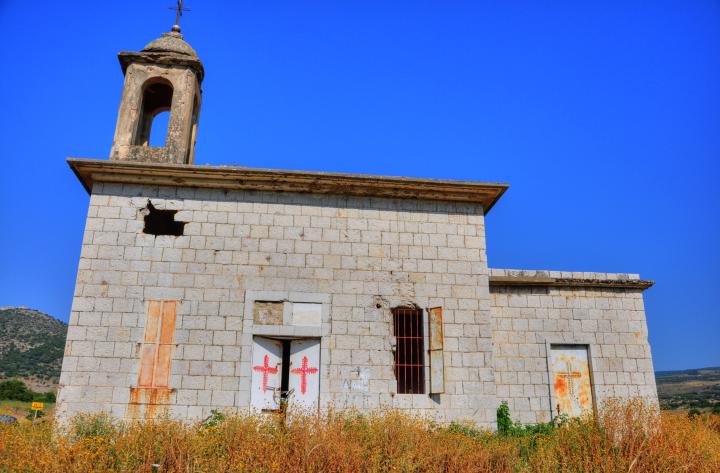An impressive Greco-Roman city located near a flowing spring – one of the sources of the Jordan river on the foothills of the Hermon mountain. A Roman sanctuary, which included temples and ritual courtyards, was built near the sacred grotto of Pan.
Home > Sites > Golan > Banias (Caesarea Philippi) – Overview
Contents:
Background:
Banias (Paneas), or Caesarea-Philippi, was an impressive Greco-Roman city located near a flowing spring – one of the sources of the Jordan river, on the foothills of the Hermon mountain. A Roman sanctuary, which included temples and ritual courtyards, was built near the sacred grotto of the Greco-Roman God Pan. The ancient city, named after Pan, was located to the south of the springs.
Josephus (Wars 1 21 3): “… the place is called Panium, where is a top of a mountain that is raised to an immense height, and at its side, beneath, or at its bottom, a dark cave opens itself”.
This is an overview page on Banias. Other pages provide more details:
-
The Sanctuary of Pan – the temples near the Grotto
-
Upper section of the Banias stream
-
The Roman city – Agrippa’s palace and other ancient remains
-
Nimrod fortress – Crusaders/Arab/Mamluk fortress above the city
-
Omrit – A newly discovered Roman imperial temple complex, south-west of Banias
Location:
Banias is located on the road (#99) that climbs up the Golan heights. The springs are located to the north of the main parking lot.
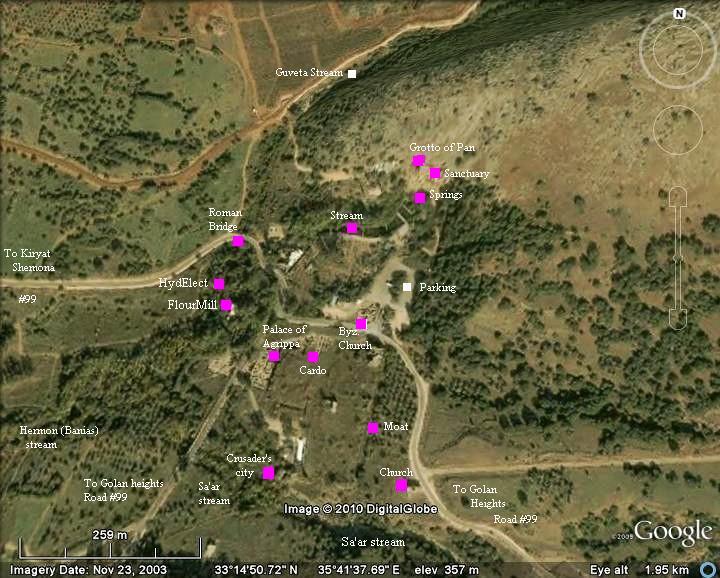
Biblical map:
Banias (Caesarea-Philippi) is located on a crossroad of major ancient routes, as illustrated below:
- Road to the north (Emesa and Syria)
- Road to East – to Damascus and beyond
- Road to south – to Sea of Galilee and beyond
- Road to west – to Tyre/Sidon and the coastline branch of Via Maris
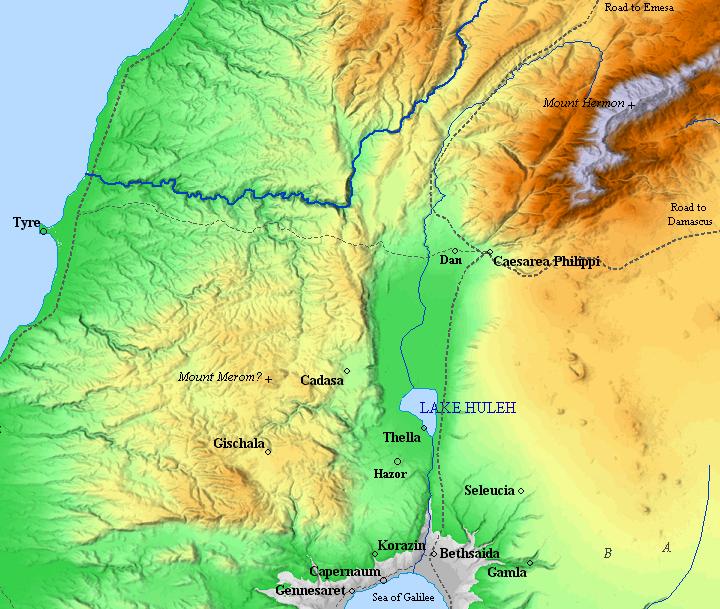
(based on Bible Mapper 3.0)
History:
- Canaanite period – nearby Leshem/Laish
Tell Dan, which is located 4KM to the west of Banias, was the earlier site of settlement from the Early Bronze age through the Iron (Israelite) Age. The ancient city – named Leshem or Laish – covers a large area – the mount size is 200Dunam (20 Hectares) and was one of the largest in the region. The springs of Banias were probably, even at the Canaanite period, a sacred sacrifice site that served the Canaanite city.
The Hebrew name “Hermon”, the mighty mountain above Banias, may have been based on the root word Herem (means out of limits or “Holy”). The Song of Solomon praises the area (4:8): “Come with me from Lebanon, my spouse, with me from Lebanon: look from the top of Amana, from the top of Shenir and Hermon, from the lions’ dens, from the mountains of the leopards”. The area is indeed is a fertile valley with plenty of water coming down from Mt Hermon and the hills around it.
- Biblical period – Relocation of Dan – BethRehob?
A large number of families from the Israelite tribe of Dan relocated during the 12th century from the central region of Israel to the area around the Canaanite city of Laish-Leshem. The area on the foothills of Mt Hermon was a perfect place.
The Bible tells how 600 families of the Dan tribe looked for a substitute for their location in the center of Israel, by sending 5 spies to the Canaanite city (Judges 18 1-2):
“…in those days the tribe of the Danites sought them an inheritance to dwell in; for unto that day all their inheritance had not fallen unto them among the tribes of Israel. And the children of Dan sent of their family five men from their coasts, men of valor… to spy out the land, and to search it; and they said unto them, Go, search the land”.
They later captured the city (Judges 8:27): “and came unto Laish, unto a people that were at quiet and secure: and they smote them with the edge of the sword, and burnt the city with fire”. The Israelites renamed the city to Dan (Joshua 19:47):
“And the coast of the children of Dan went out too little for them: therefore the children of Dan went up to fight against Leshem, and took it, and smote it with the edge of the sword, and possessed it, and dwelt therein, and called Leshem, Dan, after the name of Dan their father”.
The Bible refers to the area near Dan as BethRehob (Judges 8:28) “…and it was in the valley that lieth by Bethrehob. And they built a city, and dwelt therein.” Therefore, Banias may have been this BethRehob, Hebrew for “the house of the Road”.
This story is also associated with a statue, which was regarded as powerful deity, that the Dans stole from Micah and erected in their new city, perhaps in the cave of Banias (Judges 8:27, 30):”And they took the things which Micah had made… and the children of Dan set up the graven image”.
It is interesting that Banias is associated with statues – Micah’s (Israelite period), Pan (Hellenistic period), and the Bleeding woman (Byzantine period).
The fortified city of Dan, a Israelite city, was destroyed in 734 during the Assyrian conquest.
- Hellenistic/Hasmonean Period
The Greek rulers controlled the region following the conquest of Alexander the Great, were impressed by the majestic setting of the area around the springs. The pagan practice of sacrifice at the mouth of the cave started in the 3rd century BC and intensified during the Seleucid control (198 BC).
The Greeks established the new Greek city of Panium (Paneas) south of the springs. The first record of the city was detailed in the great battle near Banias (198 BC) between the armies of the northern Greek-Seleucids, headed by King Antiochus III, and the southern Greek-Egyptians headed by General Scopus. The Seleucids won this battle, giving them a control of the Land of Israel. Josephus (Ant. 12 3 4): “Antiochus overcame Scopas, in a battle fought at the fountains of Jordan, and destroyed a great part of his army”.
The victorious Seleucid King Antiochus III governed the Land of Israel successfully, but under his son Antiochus IV (175-164 BC) relationship with the Jewish population came to an end and resulted in the Hasmonean revolt (167-152 BC). The Hasmonean Jewish Kings first controlled Judea (152 BC-144 BC) and later expanded their control over greater parts of the Land of Israel.
The Roman historian Josephus Flavius wrote that the Golan, the north-east region of Israel, came under Jewish control in the years 83-80 BC. Alexander Janneus’s campaign on the eastern territories, the Hasmonean king captured the Golan (Wars 1: 4): “He also demolished Golan, and Seleucia, and what was called the Valley of Antiochus”. (The latter area is the valley west of Banias).
- Early Roman Period
After 20 years, after the Romans annexed the land (63 BC), General Pompey implemented political reformations, which removed the Golan from the Hasmonean state. He reassigned the north-eastern parts to the Itureans, an Arab tribe who received parts of the Galilee and the Golan. The Itureans are referred in Luke 3:1: “Now in the fifteenth year of the reign of Tiberius Caesar, Pontius Pilate being governor of Judaea, and Herod being tetrarch of Galilee, and his brother Philip tetrarch of Ituraea“.
- Herod the Great
Herod the Great, a Jewish Roman client King of Israel (39 BC-4 BC), subdued the Itureans (23 BC) following their inaction against outlaws. As a result, Augustus Caesar gave the northern Golan, including Paneas, to Herod the Great (20 BC). Josephus writes about this and added that Herod constructed a temple in honor of his beneficiary (Wars 1:21 3) : “And when Caesar had further bestowed upon him another additional country, he built there also a temple of white marble, hard by the fountains of Jordan: the place is called Panium…”. Additional temples were built in Samaria-Sebesta and in Caesarea-Maritima (“by the Sea”) which is located on the shore in the center of Israel.
The ruins of an Early Roman temple are found on the western side of the sanctuary, close to the cave of Pan, and may be this is the temple honoring Augustus. However, recent excavations identify it in Kh. Omrit which was on the southern entrance to the city.
-
Herod’s Son – Philipp
Herod’s 3 sons divided their father’s kingdom, and the Land into 5 regions (years 4 BC-6 AD) which included Herod’s sister and the area of Hippos controlled by the Syrian King. Herod’s third son, Philipp, also known as Herod II, received the area of Lake Hula, Golan and Bashan. Josephus writes about Philipp (Ant 18:5 4): “Herod [Philip], the son of Herod the Great, who was born of Mariamne, the daughter of Simon the high priest”.
Philipp made Banias his capital city, naming it Paneas-Caesarea, honoring the Roman Caesar Tiberias – son of Augustus. In order to distinguish the name (Caesarea) from the great harbor city of maritime-Caesarea, the northern city was known as “Caesarea-Philippi“. The city was greatly expanded – being the capital of a rich region, and benefitting from the prosperous years under the Romans. Philipp was King until his death (33AD).
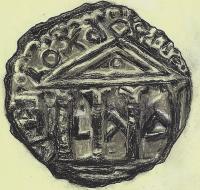
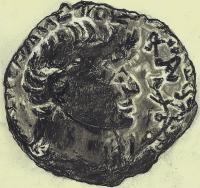
Philipp’s Coin with Tiberias, minted in Banias; dated 31AD
With Tetra-style temple (Augusteum) Drawing by Rina
-
Jesus visits in Caesarea-Philippi
Jesus visited the city around 29AD (Mark 8 27): “Now Jesus and His disciples went out to the towns of Caesarea Philippi; and on the road He asked His disciples, saying to them, “Who do men say that I am?”, and Peter confessed Jesus as the Messiah. This is one of the important Christian events, giving the city a special religious status which intensified during the Byzantine period. Another event is associated with the city and Jesus- the miracle of the healing of the bleeding woman. A large Byzantine Basilica was constructed south of the springs, dedicated to this miracle.
-
Roman period
The land and the city were inherited in 37 AD by the grandson of Herod, Agrippa I, who grew in the Roman royal court. Agrippa received the land as a gift from his childhood friend in Rome – the mad Caesar Gius Caligula (37-41 BC). The status of the city declined after Agrippa became King of Israel, since after additional regions were granted from Caligula (37 BC -41 BC), the King moved his capital to Jerusalem. However, after his son Agrippa II (King 50-95 AD) received the city (53 AD) as a present from Caesar Nero , the city was again rebuilt (61 AD) and in his honor it was renamed “Neronias Caesarea Sebaste” (Ant 20:9 4): “About this time it was that king Agrippa built Cesarea Philippi larger than it was before, and, in honor of Nero, named it Neronlas.”. A grand palace was constructed here to the east of Philipp’s palace, and was recently excavated and reconstructed. The city regained its former ancient name, Paneas, only after 181AD. The city’s Jewish name was “Caesarion” (“little Caesar”), as referred in the 2nd C Jewish religious books of Mishna.
-
Great Revolt
During the great revolt against the Romans (67-73 AD) the city spared the tragic destiny of other cities, since Agrippa II sided with the Romans. Its Jewish citizens were protected by Agrippa but were subject to harsh times. During the campaign Vespesian and his son Titus, heads of the Roman armies during the revolt, camped here (Wars 3 9 7): “Vespesian… went to that which is called Caesarea Philippi and there he refreshed his army for twenty days, and was himself feasted by king Agrippa, where he also returned public thanks to God for the good success he had had in his undertakings”. After the war there was a Jewish community here, but most of the citizens were pagan.
-
Byzantine Period
Christianity became the Roman’s state religion in the 4th century, and Paneas became a holy Christian place and an important Episcopal seat (4th-5th century), under the control of the Patriarchate of Antioch – the principal Roman city at those times (today called Antakya, in south-east Turkey) .
-
Arab Period
In the 7th century the Arabs conquered the land, renaming the city as Banias (Arabs pronounce ‘P’ as ‘B’), and the city kept its status as the capital city of the Golan area. A Jewish community resided in Banias, and their Synagogue dated to the 11th century was excavated in the area of the palace of Agrippa.
-
Crusaders
The Crusaders arrived in the Galilee in 1099 and in Banias at 1129. This frontier city, located on the trade road to Damascus, was a strategic asset. The Crusaders hoped to win the war against the Arabs by conquering Damascus, and Banias was the key for this strategy. A large wall and gate was added around the city, and its impressive ruins are visible today along the southern walls. The Crusaders fortified the Arab fortress of Kil’at Subeiba (“Large cliff”), located 6KM above the city, calling it by the Biblical name – Nimrod Fortress. The fortress and the city switched sides for some time (1132-1151), but the Crusaders regained the city and fortress until 1164 when it was conquered by the Syrian ruler Nur al-Din. Since the city was a key gateway to the small Crusader enclave, they tried to regain it in other Crusades (1217, 1253) but the city remained under Arab control.
-
Medieval times – Mongols, Mameluks and Ottomans
The city was conquered by the Mongols (1260), and in the same year it fell to the Mamelukes. The city regained its status as regional governing city in the 15th C and the Nimrod fortress became the seat of the governor reporting directly to the Sultan of Cairo. It was a major station along their most important link – the Cairo-Damascus route.
After 1516 the Turkish Ottoman empire from Turkey controlled the land and the city declined into a small village.
-
Modern Period
Following Israel’s conquest in the 6-day war (1967) the city and the fortress became a popular nature reserve. Excavations held here since 1988, directed by Prof Vasilis Tsafiris, is bringing back the glory of the city, making “the city of Pan” one of the impressive historic and nature sites in the area.
Photos :
(a) The area:
The following photo shows the greater area of Banias, a nature reserve on the foothills of the Golan, bordering with Syria. Above it is the Hermon mountain – the highest peak in the Golan. The ancient city of Banias is located on the hillside at the far right background.
Click on the photos to view in higher resolution…
The plan of the Nature reserve park, centering around ancient Banias, is illustrated below. The major sites are indicated on the map, and include the Grotto of Pan (in the north) and the sanctuary around it. The Banias springs flow near the sanctuary, and join the Guveta stream near the Roman bridge. The Banias (Hermon) stream flows to the south, with a trail leading to the falls. Ancient city of Caesarea-Philippi is located on the south side, with Agrippa’s palace on the west and the Crusader city on the east.
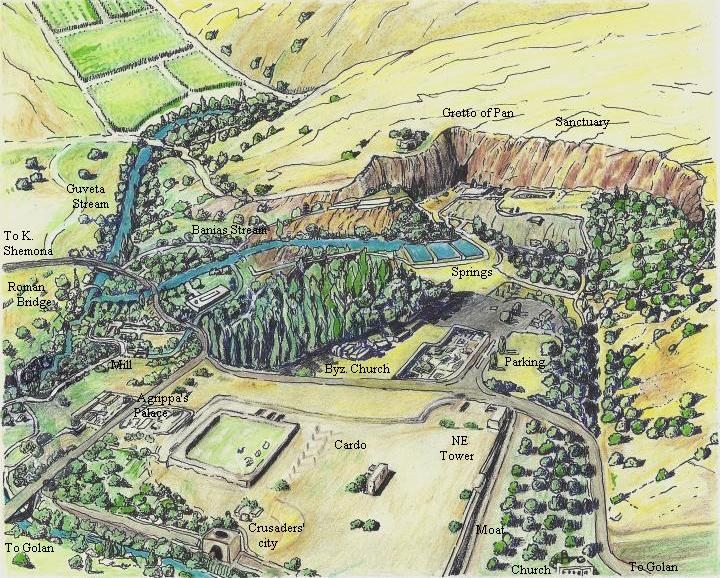
(b) The springs:
The springs of Banias were one of the important assets of the city – one of the sources of the Jordan river. The waters of the spring come from the Hermon mountain, located high above (its peak is 2814m, while the springs are at 320m above sea level).
Josephus writes about this (Wars 1:21 3) : “Now the fountains of Jordan rise at the roots of this cavity outwardly; and, as some think, this is the utmost origin of Jordan”.
Another view of the refreshing waters of the springs:
The Banias (Hermon) stream flows to the west and then turns to the south, and is the most eastern of the Jordan river sources (the other are the Dan and Senir-Hasbani). It supplies 128 million meter cube water per year, compared to 240M and 152M for the other two sources. All sources meet near Kibbutz Sde Nehemia.
The trail continues along the bank of the stream, which narrows down and pushes down south into the valley.
![]() For a detailed description of the sites along the stream – see the Banias stream page.
For a detailed description of the sites along the stream – see the Banias stream page.
(c) Grotto of God Pan and the sanctuary:
The Grotto (cave) of God Pan and the temples and ritual courtyards around it are seen in the photo. This section is located on an elevated terrace above the springs. This was the sacred place of the city.
The foundations of a number of temples and ritual courtyards are located around the cave. The Greeks sanctified the cave and dedicated it Pan, the God of shepherds and flocks, mountainside, hunting and rustic music. This gave the city its name – Panium or Panias – which is pronounced in Arabic as Banias.
The cave of Pan became a center of pagan activity starting from the Hellenistic period (from 3rd C BC). Animal sacrifices were thrown into the cave. The sacred sanctuary (temenos) received a higher status after Herod constructed a temple in honor of Augustus (16BC). Additional temples and rock-hewn niches and inscriptions were added. The pagan activity continued until the middle of the Byzantine period, around the 5th C AD, and then they were abandoned.
A reconstructed view of the temples is illustrated below.
![]() For a detailed description of the Grotto of Pan and the sanctuary – check the Banias Temples page.
For a detailed description of the Grotto of Pan and the sanctuary – check the Banias Temples page.
Drawing by Grandma Rina
(d) West side of Banias:
The Banias stream continues downstream to the south-west. A nature trail along the stream leads either to the falls – on the longer path – or on a shorter circular path around the walls of the ancient city and back to the entrance. The photo shows the site where the gushing waters from the Banias springs (flowing right to left) meet the calm waters of the Guveta stream (in the center), which flow from the mountains.
Along this path, the two streams – Banias and Guveta – join together. This junction of streams is indicated by a red square on the top-left corner of the illustration.
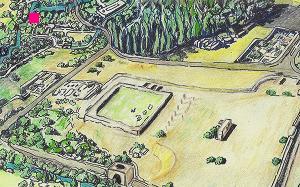
At this point, under the old road connecting to the Golan, is the base of a Roman bridge. The photo below shows the bridge from the south side. This was once a section of the ancient Roman road that led to Damascus.
(e) Roman City:
The excavations unearthed the vast Roman and Byzantine city in Banias, which was located between the Banias temples in the north and the Sa’ar stream in the south. A colonaded street -the Cardo Maximus – connected both ends of the city. A large public structure, believed to be the Palace of Agrippa II, was excavated here, as well as other structures of the period, including streets, aqueducts, courtyards, a synagogue, a Church and a bathhouse.
![]() For a detailed description of the Roman/Byzantine city – check the Roman/Byzantine City page.
For a detailed description of the Roman/Byzantine city – check the Roman/Byzantine City page.
(f) Open Museum:
Between the parking lot and the springs is an open air museum. A collection of findings from the excavations is on display.
(g) Crusaders city and Nimrod fortress:
Several sections of the Crusaders and Medieval city can be seen in Banias – three towers and segments of the walls. A well preserved gatehouse and tower stands on the south side of the city, seen in the picture below.
![]() For a detailed description of the Crusaders city – check the Banias Crusaders city page.
For a detailed description of the Crusaders city – check the Banias Crusaders city page.
Nimrod fortress (Qal’at Namrud, Qal’at Subeiba), one of the largest and most impressive fortresses in Israel, is located on a cliff high above the Banias. Initially fortified by the Crusaders, the present walls and towers were built by the Mamluks during the 13th C. The frontier fortress guarded the main road from Damascus to Tyre and Tiberias during the Crusaders period.
![]() For a detailed description – check the Nimrod fortress page.
For a detailed description – check the Nimrod fortress page.
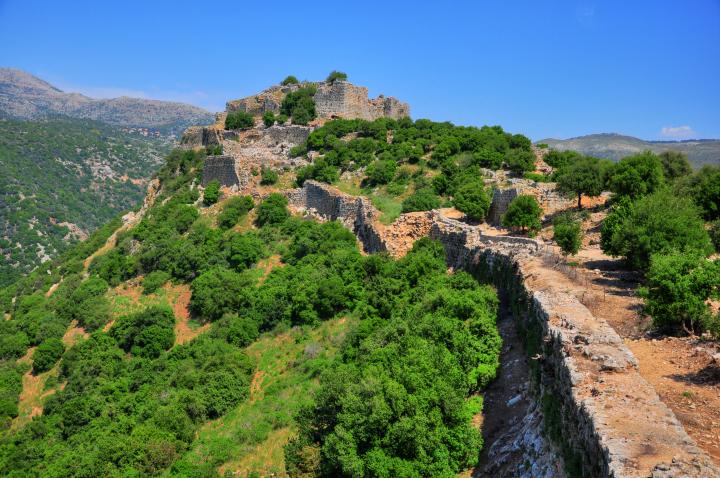
(h) Ottoman/Syrian period:
Remains of a mosque are located on the northern edge of the excavation area B, near the entrance to the parking lot. A modern mosque’s minaret, part of the deserted Syrian village, is seen below.
Other modern remains are located in other sections of the area. The following photo shows the well preserved Maronite church, which is located along the road that climbs up to the Golan heights.
A closer view of the church, from the west side. Nimrod fortress is seen on the left background:
Etymology (behind the name):
* Names of the city-
- Paneas – The city of Pan – Greco-Roman God of shepherds and flocks, mountainside, hunting and rustic music
- Panias, Panium, Panaeon – other forms of “city of Pan”
- Banias, Banyas – the Arabic name of the village – preserved its name
- Caesarea-Philippi – Caesarea is the city of Caesar; Philippi – named after Herod’s son who made the city is capital
Links:
* External links:
- Nature reserve
- Banias (in JVT)
- Banias ( in Jafi)
- Banyas (in MFA)
- Banias (in AE)
- Religious history of Banias 21BC-1635AD (Judd Burton, pdf, 232 pages, 2010) – with photos and drawings from our site
* Internal links on Banias:
- Banias – Temples – The grotto of Pan and the sanctuary
- Upper section of the Banias stream
- Banias Roman/Byzantine city
- Banias Crusaders city
- Nimrod fortress – Crusaders/Arab/Mamluk fortress above the city
- Kh Omrit – Roman temple south of Banias
* Other Internal links:
* Books:
- Caesarea Philippi: Banias, the lost city of Pan [2004] – John Francis Wilson
BibleWalks.com – have Bible will travel
Gamla <<<–previous site—<<<All Sites>>>—Next Golan site —->>> Banias Temples
This page was last updated on 14 Jan, 2013
Sponsored links:
